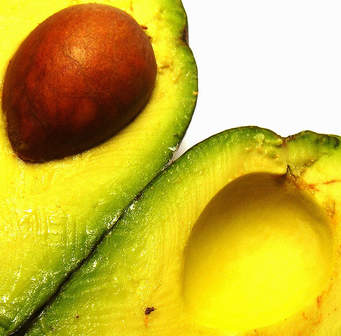




-
Avocado Oil
- Latin Name: Persea Gratissima Caertn.,
P. americana Mill
Family: Lauraceae- Etymology
Persea is the Greek name for tree and gratisima is Latin for very pleasing. Americana is indicative of its origin The Plant and its environment
The avocado tree originates from the tropical and sub-tropical areas of the Americas where it was discovered by the Spaniards in the 15th century and introduced into Europe. It now flourishes in Spain and in many other countries, eg Israel.- The oil
Avocado oil has excellent keeping qualities but should not be kept in the fridge, as some useful constituents would be precipitated. It is quite common for the oil to be slightly cloudy if in cold conditions, and there may even be a deposit present. - These two traits can be considered a good sign insofar as they indicate that the oil has not been through an extensive refining process. Avocado tends to become congealed when cold - indeed the oil solidifies at 0C but liquefies again at room temperature. The unrefined oil is deep green in colour.
- Method of Extraction
The oil is expressed from dried avocado pears which have been damaged and therefore would be unfit for marketing as fresh fruit. The fruit is peeled and the stone removed before the fleshy portion is sliced and dehydrated in an oxygen free environment at a temperature of about 130C. - Water is removed in this way in order to avoid the formation of an unusable emulsion. The dried slices are then ground before being cold pressed and filtered to produce the oil. The extraction process can be quite tricky, and true cold pressed avocado oil is not common, as the cosmetics industry is the biggest user and prefers the refined oil: this latter is a pale yellow colour, and thus is favoured by the cosmetics industry so that creams and lotions are not unduly coloured. For aromatherapy use the unrefined, green cold pressed oil is preferred.
Principal Constituents (Virgin Oil)
| Type | Based on | Content - % |
| Saturated fatty acid units: | ||
| C16:0 | Palmitic acid | 10-22 |
| C18:0 | Stearic acid | <3.0 |
| Typical fatty acid unit content | 19 | |
|
Monounsaturated fatty acid units: |
||
| C16:1 | palmitoleic acid | 1.0-10 |
| C18:1 | oelic acid | 66 (59-75) |
| Typical monounsaturated fatty acid unit content | 68 | |
| Polyunsaturated fatty acid units: | ||
| C18:2 | linoleic acid | 12 (8-14) |
| C18:3 | alpha linolenic acid | <5.0 |
| Typical polyunsaturated fatty acid unit content | 13 |
Physical Properties
| Odour | Similar to the ripe fruit in its native country |
| Acid Value | 0.2 max |
| Specific Gravity | 0.91 - 0.92 |
| Energy value Kcal/100ml | 895 |
- Vitamins
- Vitamins A, B1, B2 and D
- Minerals
Potassium, phosphorous, magnesium, sulphur, calcium, sodium, copper. - Folk-lore and traditional Plant uses
At one time avocado oil was believed to be an aphrodisiac. Avocado has been used as a hair pomade to stimulate hair growth, to hasten suppuration and also as an emmenagogue (Leung & Foster 1996). - Therapeutic Properties - Internal Use.
The avocado is almost a complete food and is easily digested. It is of help with gastric problems, constipation, urinary infection and the treatment of liver and gall bladder conditions. - Therapeutic Properties - Internal Use.
The avocado is almost a complete food and is easily digested. It is of help with gastric problems, constipation, urinary infection and the treatment of liver and gall bladder conditions. - Therapeutic Properties - External Use
A superb emollient
Has a reputation for having a higher degree of penetration into the epidermis than most carrier oil
Valuable in massage and muscle preparations
Said to have skin healing properties (Leung & Foster 1996)
Has been used in raynaud's disease (Stier 1990)
Moisturizing, softening, anti-wrinkle (prevents premature ageing)
Especially recommended for dry skins
For general skin inflammation
A non-saponifiable fraction in the oil is sometimes isolated, and this is good for maintaining suppleness of the skin in post-menopausal women.- Cosmetic Use
Avocado oil is rich in lecithin and is widely used in cosmetic preparations , including lipsticks. A mask of crushed avocado pulp left on the face for twenty minutes both cleanses and moisturises the skin. Used in equal quantities wtith sesame and olive oils it affords some protection from the sun. - Culinary Use
Avocado flesh is a very useful food on account of its vitamin and mineral content. Proteins are also present together with 20% fat, so the fruit is not slimming! It is used extensively in salads and starters and when emulsified it is particularly digestible. The pulp has been used for thousands of years in tropical America and is a good source of vitamin D, higher than in butter or eggs (Joslyn & Stepka 1949), and potassium (Leung & Foster 1996). - Cautionary Notes
The colourless bleached oil which is more generally available ( strangely enough, at a slightly higher price!) dhould not be used therapeutically for obvious reasons. Some of the active ingredients of avocado oil are often isolated for use in cosmetics. Avocado oil used in shampoo and tested on the skin and eyes of both animals and people showed some irritation, but there was no evidence of sensitisation (Winter 1982). Poisioning of cattle, horses, goats, rabbitss, canaries and fish by avocado (leaves, fruit, bark, seeds) has been reported (Lewis & Elvin-Lewis 1977). - Reference: Carrier Oils For Aromatherapy & Massage / Len Price with Ian Smith & Shirley Price
